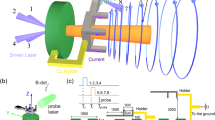Abstract
The astrophysical jet experiment at Caltech generates a T=2–5 eV, n=1021–1022 m−3 plasma jet using coplanar disk electrodes linked by a poloidal magnetic field. A 100 kA current generates a toroidal magnetic field; the toroidal field pressure inflates the poloidal flux surface, magnetically driving the jet. The jet travels at up to 50 km/s for ∼20–25 cm before colliding with a cloud of initially neutral gas. We study the interaction of the jet and the cloud in analogy to an astrophysical jet impacting a molecular cloud. Diagnostics include magnetic probe arrays, a 12-channel spectroscopic system and a fast camera with optical filters. When a hydrogen plasma jet collides with an argon target cloud, magnetic measurements show the magnetic flux compressing as the plasma jet deforms. As the plasma jet front slows and the plasma piles up, the density of the frozen-in magnetic flux increases.
Similar content being viewed by others
References
De Young, D.S.: Science 254, 389 (1991)
Hsu, S.C., Bellan, P.M.: Mon. Not. R. Astron. Soc. 334, 257 (2002)
Hsu, S.C., Bellan, P.M.: Phys. Rev. Lett. 90, 215002 (2004)
Kumar, D.: Ph.D. dissertation. California Inst. Technol., Pasadena, CA (2009)
Lynden-Bell, D.: Mon. Not. R. Astron. Soc. 369, 1167 (2006)
You, S., Yun, G.S., Bellan, P.M.: Phys. Rev. Lett. 95, 045002 (2005)
Yun, G.S., Bellan, P.M.: Phys. Plasmas 17, 062108 (2010)
Yun, G.S., You, S., Bellan, P.M.: Nucl. Fusion 47, 181 (2007)
Author information
Authors and Affiliations
Corresponding author
Rights and permissions
About this article
Cite this article
Moser, A.L., Bellan, P.M. Observations of magnetic flux compression in jet impact experiments. Astrophys Space Sci 337, 593–596 (2012). https://doi.org/10.1007/s10509-011-0860-1
Received:
Accepted:
Published:
Issue Date:
DOI: https://doi.org/10.1007/s10509-011-0860-1




